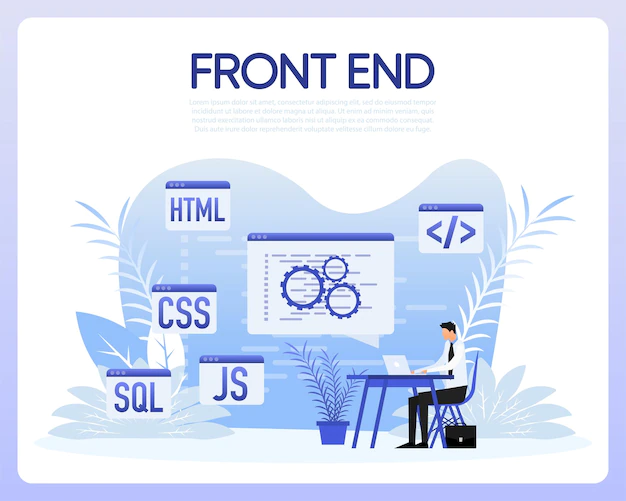
Introduction – Why Frontend Development Matters Now
Frontend development in 2025 is evolving fast across the USA and UK, driven by AI, performance innovation, accessibility, and immersive experiences. Discover key trends, skills, and strategies top teams must master to stay competitive and deliver exceptional digital experiences.
In today’s digital era, frontend development is no longer just about styling buttons or building interactive interfaces. For teams operating in the USA and the UK in 2025, the frontend is the experience layer of your brand—the moment users engage, convert and remain loyal. With rising expectations for speed, accessibility, immersive experiences and seamless cross-device performance, a high-quality frontend is a competitive differentiator.
According to recent data, the global frontend developer population is rising, and demand for skilled frontend roles is growing noticeably in the US and UK markets. Additionally, users in both markets expect near-instant load times, flawless mobile experiences and intuitive interfaces—failure to meet these expectations often means abandonment. In this climate, frontend development isn’t just technical—it’s strategic.
Over the next few sections, we’ll explore the major trends shaping frontend development in the USA and UK, what your team or business must prioritise, how to hire or build the right talent or partner, how to measure success, and what the future holds beyond 2025.
Top Trends Shaping Frontend Development in the USA & UK
AI-powered tools, automation & code-generation
One of the most significant shifts is the rise of AI in frontend workflows. Developers increasingly rely on AI tools for code generation, UI/UX suggestions, and test automation. According to trend reports, tools that generate snippets, assist in boilerplate code and even suggest UI improvements are becoming mainstream.
For teams in the USA & UK, this means faster iteration, fewer repetitive tasks, and more room for creative work. But it also means developers must adapt to a changing workflow: those who resist this shift risk falling behind.
WebAssembly, high-performance apps & browser evolution
Performance is no longer optional—it’s expected. Platforms like WebAssembly (Wasm) are being adopted to bring near-native speed to browser experiences, handling intensive computations, graphics, and immersive UIs.
In the UK market, for example, WebAssembly is cited as a key performance enabler for rich web apps in 2025. Businesses in the US and UK aiming for high engagement (e-commerce, media, fintech) must consider performance-first frontends—and Wasm is part of that future.
Micro-frontends, component-driven architecture & Jamstack
Architectural patterns are evolving. Micro-frontends—splitting large frontends into independent teams/modules—are gaining traction, especially in larger organisations.Component-driven development, design systems, and Jamstack approaches (JavaScript, APIs, Markup) allow for more modular, maintainable frontends. Industry reports place these as central to frontend architecture in 2025.
For USA/UK teams, this means choosing the right architecture early to scale, maintain and evolve applications without major rewrites.
Accessibility, inclusive design and regulatory compliance (USA/UK)
Especially for the UK market—and increasingly for US audiences—accessibility and inclusive design are becoming non-negotiable. Semantic HTML, ARIA attributes, keyboard navigation, screen-reader compatibility—they’re all expected by both users and increasingly by regulators.
Similarly, regulatory standards around data privacy and regional compliance add another layer to frontend development. Developers must integrate these concerns into the frontend workflow, not treat them as afterthoughts.
Mobile-first, PWAs and immersive experiences
Frontends must be mobile-first. In both the USA and UK, mobile traffic often dominates, and users expect app-like experiences on the web: fast, responsive, offline-capable. Progressive Web Apps (PWAs) and immersive experiences, including voice and 3D, are becoming standard.
For businesses and developers serving these markets, this means planning for cross-device experiences, fluid navigation, and meaningful interactions—not just “mobile friendly” layouts.
What Frontend Teams Should Prioritise in Their Workflow
Defining clear business goals and user-centric front-end strategy
Start with why. Do you want to improve conversion, reduce bounce, enhance engagement, or support global expansion? The frontend must align with business objectives. Especially for USA and UK audiences, understanding regional user behaviour, device preferences and performance expectations is key.
Create user personas, outline user journeys specific to your target market, and define measurable goals (e.g., time to interactive , bounce rates, conversion uplift). A front-end team without a strategy is building in the dark.
Tech-stack choices: frameworks, libraries & modular design
In 2025, your front-end tech stack matters. Popular choices include React, Vue.js, Svelte, TypeScript and frameworks like Next.js But more importantly, pick what suits your team’s expertise, project size and maintainability. Consider architecture (component-driven, micro-frontends), deployment (edge, serverless) and global performance (CDNs, localisation).
Avoid chasing “shiny” frameworks for the sake of it—success comes from choosing appropriate tools and building in a modular, maintainable way.
Performance optimisation: load time, core web vitals, progressive enhancement
Performance is now a first-class citizen. Google’s Core Web Vitals (Largest Contentful Paint, First Input Delay, Cumulative Layout Shift) are key performance indicators. A recent study notes many developers aim for near-instant load times in 2025.
Techniques include code-splitting, lazy loading, adaptive hydration, service workers for PWAs, and WebAssembly for heavy tasks. For USA/UK users—used to high-quality experiences—front-end performance directly links to user satisfaction, SEO and conversion.
Collaboration between design, UX and front-end engineering
Modern front-ends demand closer collaboration between designers, UX experts and developers. The boundaries are fading: developers need to understand motion design, accessibility, UX flows; designers must understand what’s feasible and performant. In the UK market especially, teams now expect developers to traverse beyond “coding” into UX strategy
Encouraging co-creation, shared design systems, and early performance/UX testing helps eliminate rework and ensures better user outcomes.
Maintenance, scalability and future-proofing your front-end
Launching a front-end is one thing—maintaining it is another. Choose architectures and workflows that support updates, team growth, modular features, internationalisation (especially relevant for USA/UK expansion), and changing user demands.
Define a roadmap for updates, performance monitoring, accessibility audits, and refactoring. Teams that built monolithic front-ends in the past are paying the technical debt today; avoid that trap.
How to Hire or Build the Right Frontend Development Team or Partner

Assessing technical expertise & relevant frameworks in USA/UK market
When hiring developers or selecting a partner agency, check for: experience with modern front-end frameworks (React/Next.js, Vue, Svelte), component systems, micro-frontends, performance optimisation and cross-device work.
Ask for case studies with measurable outcomes (USA/UK clients preferred). Technical interviews should probe understanding of accessibility, performance, architecture and maintainability—not just “can you write React code”.
Evaluating cultural and regional nuances: US vs UK considerations
For USA vs UK markets, differences matter: spelling/phrasing, date/currency formats, device usage patterns, regulatory frameworks, payment methods (if applicable). A partner or team aware of both markets adds value for cross-border or global projects.
If your user base spans both, planning for localisation (en-US vs en-UK), hosting/CDN infrastructure, time-zone coordination and support model becomes important.
Communication, time-zones, process and agile workflows
Modern front-end development demands agile workflows, frequent releases, incremental updates, and fast feedback loops. Ensure your team or partner has transparent processes (sprints, retrospectives), tooling (CI/CD, code reviews), and communication cadence suitable for US/UK stakeholders.
Miscommunication or poor process reflects in delayed launches, hidden bugs and frustrated stakeholders.
Cost vs value: pricing models and total cost of ownership
When considering cost, look beyond the sticker price. Evaluate what’s included: performance optimisation, accessibility audits, internationalisation support, documentation, future-proof architecture.
A slightly higher upfront investment often yields lower maintenance cost, better user experience and higher business ROI—especially in mature markets like the USA and UK.
Legal/regulatory aspects: data privacy, accessibility, localisation
Ensure contracts cover ownership of code, IP, regional compliance (accessibility laws in the UK/EU, data privacy laws in the US), hosting/regional data storage. Ask about maintenance of updates, security patches, and accessibility compliance. For UK clients especially, accessibility regulations are evolving rapidly; your front-end team must know them.
Measuring Success – Key KPIs & Metrics for Frontend Development

Performance metrics: LCP, FID, CLS, load-time
Track Core Web Vitals and other performance metrics regularly. These directly influence SEO, user satisfaction and bounce rates (especially in USA/UK markets). Improvement in these metrics often correlates with higher engagement and conversions.
Engagement metrics: bounce rate, pages per session, conversion rate
Frontend quality shows up in user behaviour: lower bounce rates, higher pages per session, improved conversion rates. Segment these by region (US vs UK) to detect regional differences and optimize accordingly.
Quality metrics: accessibility audit results, error/crash rates
Accessibility compliance (WCAG) and error monitoring (JS errors, UI bugs) reflect the robustness of your frontend. For businesses targeting UK or EU audiences, monitor accessibility scores and ensure compliance.
Scalability metrics: code maintainability, modularity, deployment frequency
How often can you deploy updates? How modular is your codebase? How many components are re-used across projects? These internal metrics affect speed to market and cost of future changes.
User-satisfaction metrics: NPS, feedback, international/regional performance
Collect qualitative feedback (Net Promoter Score, user surveys) and regional performance data (load times by location, device type). For global-enabled front-ends targeting USA/UK, ensure region-specific performance and experience are excellent.
Future Outlook – What’s Next in Frontend Development Beyond 2025
Real-time experiences, WebXR & immersive web apps
The frontier of frontend development is moving toward immersive web applications (WebXR, AR/VR in browser), real-time collaboration tools and richer interactivity. Teams in the US/UK preparing for this will lead the pack.
Generative AI in frontend design, adaptive UIs & voice interfaces
Generative AI will increasingly shape UIs: dynamic layouts, voice-enabled front-ends, adaptive designs that respond to user behaviour and device context. Developers will collaborate with AI as co-designers and co-coders.
Globalisation: multi-region optimisation, localisation, edge deployment
As businesses expand beyond local markets, front-ends must support multiple languages/currencies, localised UX, edge-hosting for global performance and regional compliance. USA/UK teams should build with global growth in mind.
Ethical, inclusive & sustainable frontend practices
Front-end development is not just about features—it’s about impact. Accessible design, low-carbon hosting, inclusive interfaces, transparency in data use will become differentiators. Front-end teams that embed ethics and sustainability will earn trust and competitive advantage.
The blurring line between frontend, backend and full-stack roles
As front-ends become more complex (with headless architectures, micro-frontends, web-assembly), the distinction between frontend and backend will blur. Developers will need broader skills, and teams will evolve into feature-focused, cross-discipline units.
Conclusion
Front-end development in 2025 for USA & UK teams is far more than building an interactive web page. It’s about crafting strategic, high-performance, inclusive, future-proof front-ends that deliver business outcomes.
Here’s a quick recap:
- Stay ahead of trends: AI tools, Wasm, micro-frontends, accessibility, mobile-first.
- Align your front-end with business goals, choose the right tech stack, optimize for performance and collaboration.
- Hire or partner wisely: assess expertise, regional nuance, process, cost and compliance.
- Measure success broadly: performance, engagement, quality, scalability and user satisfaction.
- Look ahead: immersive experiences, generative UI, global readiness, ethical design.


